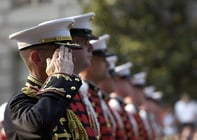Published on
How Higher Education Needs to Change to Better Serve Veterans

As a society, we must own our obligation to provide a way to welcome veterans back to the community, due to their service in the military. Institutions of higher learning—because of their unique position outside of, but frequently in partnership with government, and the public and private sectors—are well poised to take the lead in this venture. Higher education institutions need to extend their expertise in building community partnerships to build a service network for veterans that includes the Veterans Administration and the public and private sectors. Internally, veterans’ services in colleges and universities must function as the core of an institution’s network to support veteran students, as opposed to stand-alone offices that process benefits. The primary goal should be to recognize and value the fact that veterans bring skills and experiences back into society that should be embraced and leveraged to strengthen the community.
In support of veteran reintegration, institutions of higher education can implement the core of what we as continuing educators do: providing excellent academic resources and constructing community partnerships. As the mission of higher education has been to serve the public through teaching and research, as well as a myriad of community partnerships, it must also be expanded to provide a meaningful role in the community for those who have served. Higher education has a long history of creating interactive processes involving government, corporations, and community organizations. We can build on these processes to create an active network that supports veterans upon separation from the military throughout their lives and careers. The reintegration of veterans into civilian academic and professional arenas is a local community function. There is a need for collaboration among institutions of higher education, nonprofits that serve veterans, and the Veterans Administration to facilitate the process of societal adaptation of veterans into academic and professional communities, and to ensure the shared, mutual ownership of this process and these communities among stakeholders.
Years in a military environment can condition an individual to follow a prescribed order and set of rules—a type of bureaucracy that is not paralleled in academic or professional environments in the private sector. The coordination of services upon separation from the military and throughout the reintegration process could assure that guidance and expertise is provided to veterans through veteran’s services centers, as well as referral to external support networks for counseling and employment services. As I mentioned in a previous article, “veterans can find the structures and bureaucracies of colleges and universities challenging and difficult to negotiate, and a centralized resource to demystify and make transparent the policies and procedures is a solid investment that saves time and streamlines the experience of veterans as they become oriented to dramatic changes in life, work and study environments.”
The re-integration of veterans requires a two-way adaptation; society needs to adapt to the changes in the individuals and society needs to give these veterans a meaningful role in the community (social, academic, professional, vocational). We need to:
- Leverage the strengths of the local community/region and streamline them.
- Enhance and share college and university resources with external partners to elevate the quality of service to veterans in a mutually cost-effective manner for the partners.
- Engage community partners in the procurement and construction of new resources to provide essential new services to veterans.
Institutions of higher education can identify all stakeholders such as partner colleges and universities, nonprofits that serve veterans, the Veterans Administration, and corporations. In collaboration, these entities can develop a structure that mirrors the mission and values and strengths of the region and tie the university-based organization into the local infrastructure that supports veterans. A leadership core from each sector could develop a leadership and decision-making process that is cooperative and engages and listens to everyone. Further, the strengths of each should be leveraged rather than duplicated. Educational institutions, from community colleges to public and private research universities, should focus on their strengths in teaching, and work in collaboration to create channels for veterans where their educational needs are best met. Similarly, the expertise of the VA and that of organizations that address workforce development, child and family development, substance abuse and homelessness, should be leveraged in this partnership.
In an era when we as academic leaders are looking closely at the definition of credit hours, and working to ensure that our curricula lead to the development of specific competencies across disciplines, we must expand this evaluation to competencies that veterans bring from their military experience. Beyond programs like the College Level Examination Program (CLEP) and Defense Activity for Non-Traditional Education Support (DANTES), we need to construct methods of mapping competencies from the military, such as leadership, cross-cultural awareness and communication, inter-cultural communication, fluency in multiple languages, written and oral communication, quantitative reasoning, et cetera.
We have learned from past and present military conflicts the tragic consequences of failed reintegration of veterans. First and foremost, the initiative must seek to meet the needs of veterans in the social, academic, and work spheres; bringing the whole person back in, psychologically, academically and professionally. Veterans need a meaningful role in the community (jobs, education and mentoring, either as the mentor or mentee). Institutions of higher learning across the nation can lead initiatives that support and facilitate the adaptation of veterans into academic, professional and social communities.
Some examples of activities to support university internal and external networks for veterans:
Co-curricular opportunities:
- Student Veterans Organizations
- Student newsletter opportunities
- Community events
- Other leadership opportunities
- First year experience course for veterans
Student Services:
- Study Abroad (create veteran-friendly opportunities)
- Student payment calculator (financial service worksheet)
- Career Fairs (specifically recruit Military, VA, etc.)
- Survey (veteran students provide input on what programs, services, workshops will be of value)
- Checklist (a resource to assist veteran students in understanding the procedures and policies regarding their education benefits)
- Research and develop resources to address suicide prevention
- College Application Essay Workshop
- Veterans student open houses
- Veterans student orientations
- Military to Civilian Resume Workshop
- Withdraw process
- Scholarship Database (Provide a resource for students to search for scholarship assistance)
External Partnerships:
- Veterans Administration
- American Veterans (AMVETS)
- Disabled American Veterans
- Paralympics
- Defense and Veterans Brain Injury Center
- Associations for individuals with disabilities
- Department of Education Bureau of Postsecondary Services
- Approve distance learning for funding with the VA
- VA—Homeless Services
- VA—Compensated Work Therapy Supported Employment Program
- VA—Woman’s Veterans Program
- Veterans Leadership Program
- Several Family Readiness Groups (can provide assistance with mobilizations)
- Organizations to support veteran entrepreneurship
- Vets4Vets (and other veteran peer support groups)
- RecruitMilitary
- Greyhounds for Heroes (provides service dogs for veterans, service of companionship)
- Wounded Warrior Program
- State Police (career service opportunity)
- Veterans Services of local counties
- IAVA—Iraq and Afghanistan Veterans of America
- External Project Plan (off-campus events at reserve and active duty location)
- Military-Friendly School Application
- Servicemembers Opportunity Colleges (SOC) Consortium



